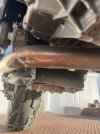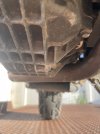D
Deleted member 1183
With regard to wheel bearing failure, do they give some indication they are in need of service? Or do they just fail suddenly and spontaneously?
My experience is that they go gradually at first and one can notice play in the bearing by rocking the wheel, holding it on top and bottom when off the ground. .You may notice a deterioration in handling but by then things have well advanced. I have had bearings fail on my former Silverwing and NC700X. On both I noticed play when changing tyres.





